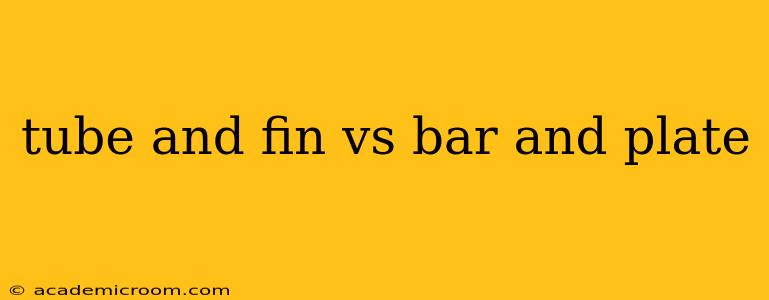Choosing the right heat exchanger is crucial for efficient thermal management in various industrial applications. Two popular types often considered are tube and fin and bar and plate heat exchangers. While both excel at transferring heat, they differ significantly in design, performance characteristics, and suitability for specific applications. This comprehensive guide will delve into the key differences, helping you make an informed decision.
What is a Tube and Fin Heat Exchanger?
Tube and fin heat exchangers are characterized by their design: bundles of tubes are surrounded by fins, significantly increasing the surface area available for heat transfer. The fins, typically made of aluminum or copper, enhance convection, accelerating the rate of heat exchange between the fluid flowing inside the tubes and the surrounding fluid or air. This design makes them particularly effective in applications where one fluid has a significantly higher heat transfer coefficient than the other, such as air cooling.
Advantages of Tube and Fin Heat Exchangers:
- High surface area: The extended surface area provided by the fins dramatically improves heat transfer efficiency.
- Compact design (in some cases): While large units can be bulky, smaller tube and fin exchangers can be relatively compact.
- Cost-effective: Generally less expensive to manufacture than other heat exchanger types, especially for larger capacities.
- Suitable for high-pressure applications: Robust construction can withstand significant pressure differentials.
- Wide range of materials: Available in various materials, allowing for adaptability to different fluids and operating conditions.
Disadvantages of Tube and Fin Heat Exchangers:
- Cleaning difficulties: The complex geometry can make cleaning challenging, particularly if fouling occurs.
- Pressure drop: The fins can increase pressure drop, reducing efficiency in certain applications.
- Not ideal for all fluids: Not suitable for highly viscous or fouling fluids.
What is a Bar and Plate Heat Exchanger?
Bar and plate heat exchangers feature a unique design consisting of a series of parallel plates with embedded bars. These bars create channels for fluid flow, maximizing surface area and facilitating efficient heat transfer between two fluids. The compact design often makes them a space-saving option.
Advantages of Bar and Plate Heat Exchangers:
- Compact design: Occupies less space compared to other heat exchangers of similar capacity.
- High heat transfer efficiency: The intricate design offers excellent heat transfer performance.
- Easy cleaning: Simple design allows for easier cleaning and maintenance.
- Lower pressure drop: Generally results in lower pressure drop compared to tube and fin exchangers.
- Suitable for viscous fluids: Can handle more viscous fluids effectively.
Disadvantages of Bar and Plate Heat Exchangers:
- Higher manufacturing cost: Typically more expensive to manufacture than tube and fin exchangers.
- Limited pressure and temperature range: May have limitations on maximum pressure and temperature compared to tube and fin designs.
- Material limitations: Fewer material options compared to tube and fin exchangers.
Tube and Fin vs. Bar and Plate: Key Differences Summarized
| Feature | Tube and Fin | Bar and Plate |
|---|---|---|
| Design | Tubes with surrounding fins | Parallel plates with embedded bars |
| Surface Area | Very High | High |
| Cost | Generally lower | Generally higher |
| Cleaning | Difficult | Easy |
| Pressure Drop | Higher | Lower |
| Compactness | Can be compact, depends on size | Highly compact |
| Fluid Viscosity | Less tolerant of high viscosity fluids | More tolerant of high viscosity fluids |
| Pressure Rating | Generally higher | Typically lower |
Which Type is Right for Your Application?
The best choice between a tube and fin and a bar and plate heat exchanger depends entirely on your specific application requirements. Consider the following factors:
- Fluid properties: Viscosity, fouling tendency, and pressure.
- Heat transfer requirements: Desired heat transfer rate and temperature difference.
- Space constraints: Available space for installation.
- Budget: Cost of the heat exchanger and its lifecycle costs (including maintenance).
- Operating pressure and temperature: Maximum operating pressure and temperature.
What are the common applications for each type of heat exchanger?
Tube and fin heat exchangers are frequently used in applications like air cooling of process fluids, refrigeration systems, and automotive radiators. Bar and plate heat exchangers find applications in HVAC systems, chemical processing, and food and beverage industries where compact design and ease of cleaning are crucial.
What materials are typically used in each type of heat exchanger?
Both types utilize a range of materials, with tube and fin exchangers often employing copper, aluminum, or stainless steel. Similarly, bar and plate exchangers can use stainless steel, titanium, or other corrosion-resistant materials depending on the application.
How do I choose the right size for my application?
Determining the correct size requires careful consideration of heat duty, fluid flow rates, and temperature differences. Consulting with a heat exchanger specialist is recommended to ensure the selection of an appropriately sized unit for optimal performance.
By carefully weighing these factors, you can select the heat exchanger that best meets your needs, ensuring optimal performance and efficiency in your system. Remember that consulting with a heat exchanger specialist is always advisable for complex applications.
